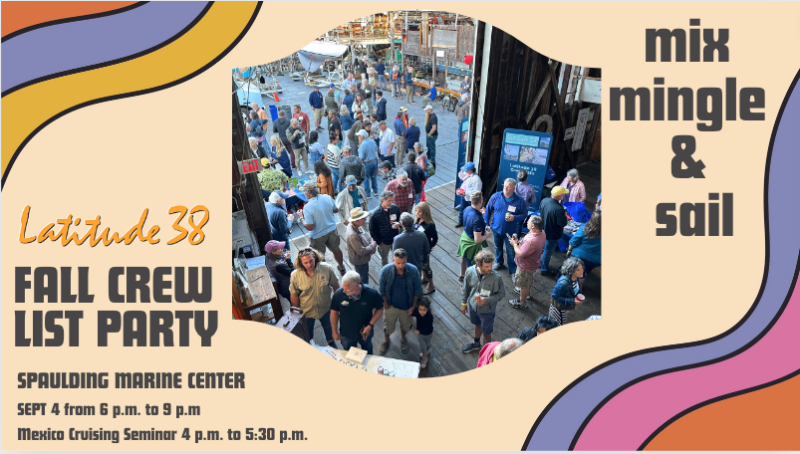
Merit 25s and the Photo of the Week From Sequoia Yacht Club
Carol Bagley sent in the Sequoia Yacht Club photo of the week with a report from their Wednesday evening beer can series. As we write, the South Bay is also active with the Peninsula Youth Sailing Foundation hosting the C420 North American Championship. It reminds us that sailors are on the water all the way from Redwood City to Stockton.
Carol got word from Spinnaker Sailing that the boats in the picture below are two of the 16 Merit 25s that Spinnaker has in its one-design fleet. The boat on the left is skippered by Juan Blanch; his crew are Michal Galik, Brian Hughes and Hong Cai. The boat on the right is skippered by Brett Herr, and his crew are Jon McCarty, Isabelle Liu, Ben Carman and Brian Ford.
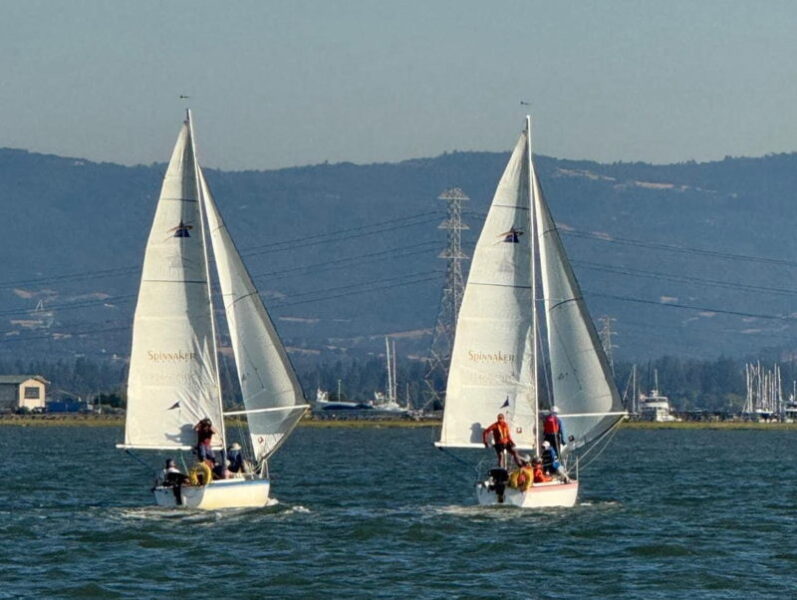
Carol noted, “The winning photo this week illustrates the neck-‘n’-neck competition of our Merit 25 One Design Fleet. We had a TIE this week! Amazing!”
Along with the photo of the week we received a bit of history on the popular Merit 25: The Merit 25 has been a popular one-design boat on the Bay since its inception in 1978. Designed by Paul Yates, 780 were built by Merit Marine.
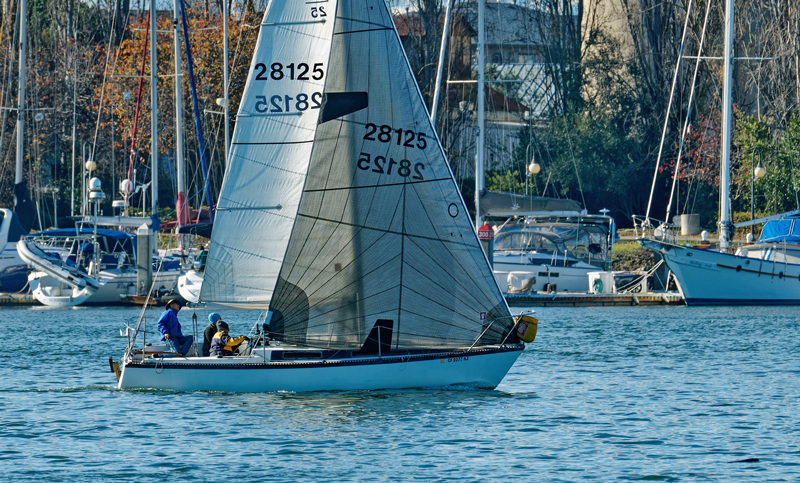
Inspired by the J/24, the Merit 25 does have some noticeable differences. It’s stronger, more comfortable, and arguably faster in certain conditions. It’s a boat that performs well in light winds and is easily handled in the stronger winds here on the Bay.
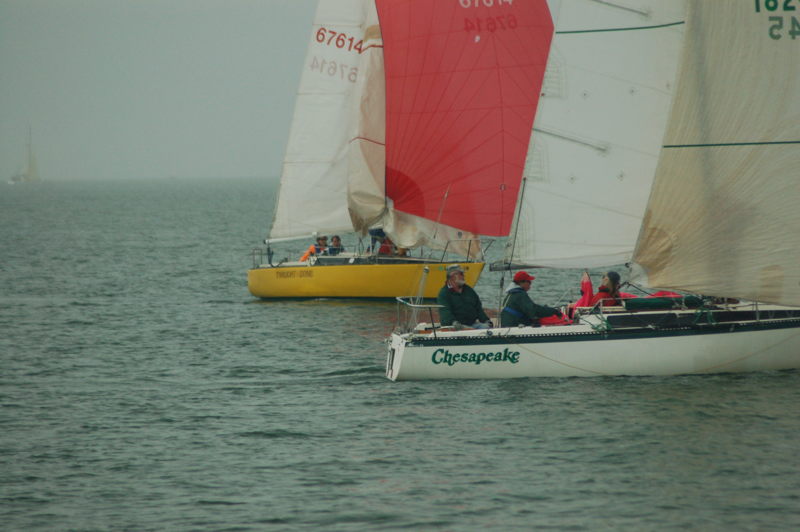
The Merit 25 one-design fleet on the Bay was at its peak in the mid ’80s with 15+ boats at the start line. Now, Spinnaker Sailing’s one-design fleet consists of 16 boats, and it’s not uncommon to get 10+ out on the water for the Sequoia Yacht Club’s Wednesday Sunset Series.
Spinnaker has raced the entire fleet during corporate team-building regattas and their annual Cheeseburger Regatta. To our knowledge, Spinnaker has the largest fleet of Merit 25s in the country. Even being 40+ years old they continue to be a pleasure to sail.
Thanks to Carol for the photo and slice of sailing life in the Sequoia Yacht Club neighborhood.
If you have a photo and slice of sailing life in your sailing ‘hood, send it to [email protected].
If you’re looking for a great deal on a boat in the 25-ft range (Including a 1972 Westerly 26 for just $1!) check out the current listings in Latitude 38’s Classy Classifieds.
NOAA’s Services Threatened Under Project 2025
In 2019 we wrote about the threat to America’s free weather forecasts provided by the National Oceanic and Atmospheric Administration — NOAA, a government agency — due to a proposal for privatization. While that year’s immediate concerns eventually abated, the issue is again raising its head with the information available in Project 2025.
The Atlantic writes, “Project 2025 — a nearly 900-page book of policy proposals published by the conservative think tank the Heritage Foundation — states that an incoming administration should all but dissolve the National Oceanic and Atmospheric Administration, under which the National Weather Service operates.” Following is an excerpt from the document that reads, “NOAA should be dismantled and many of its functions eliminated, sent to other agencies, privatized, or placed under the control of states and territories.” In other words, “fully commercialize its forecasting operations.”
Currently, NOAA provides weather information that is accessible to everyone, for free. The organization is responsible for forecasts that enable people to prepare for severe weather events such as hurricanes, severe storm and rain events, and these days, heat waves. Privatizing this service suggests these forecasts would be available only to those with the means to pay for them.
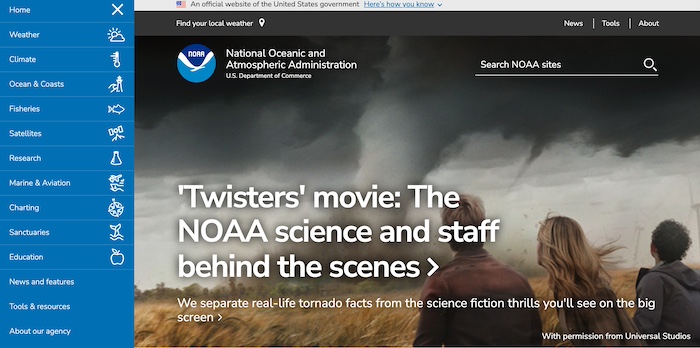
Yes, there are already a number of paid weather services available, some of which are used by mariners, but can you imagine not being able to quickly look up the weekend’s forecast to see how the Bay will look for sailing?
NOAA is also the source for much of the world’s data on climate and the changing atmospheric conditions, used by “scientists around the globe.”
This story runs far deeper than our few paragraphs, and we encourage you to read more and inform yourself about what Project 2025 has in store for the nation’s weather service and many other US institutions.
Get the Best Bottom Painting Package on the Bay
Sailing “Just a Lap” Around the World for Charcot-Marie-Tooth Disease
Jenny Decker is attempting to enter the Guinness Book of World Records as the first person to sail around the world solo with Charcot-Marie-Tooth disease (CMT). The 40-year-old is sailing to create awareness of the disease and encourage people to support the “groundbreaking” research being done by the CMT Research Foundation. She has named her journey Just a Lap.
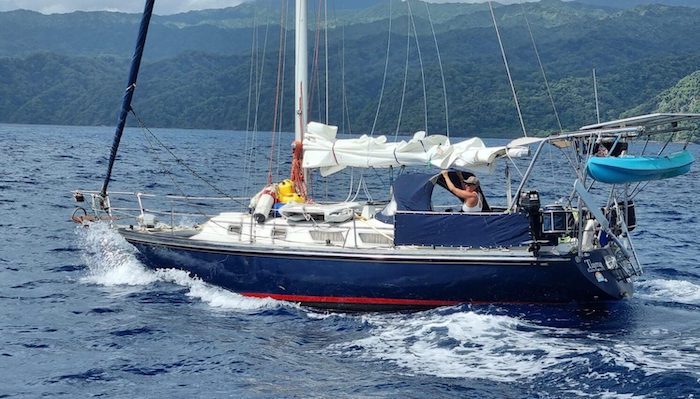
“Only a few hundred people have solo-sailed around the world and I will be the first to do so with CMT. More people have been to space,” Jenny writes about her reasons for casting off. “It’s such a rare feat it seemed perfect for a rare yet special disease. Most people have never even heard of Charcot-Marie-Tooth disease, so how are we even supposed to raise money for research toward a cure?”
The idea of Just a Lap began after Jenny became the first known solo person to circumnavigate the Big Island of Hawaii by kayak. “After that beautiful and terrifying adventure I wanted to raise the bar to truly inspire those with this disease, or any disability, that despite your physical attributes, you can do anything you put your mind to,” she adds.
In 2017, she began sailing with friends in Hawaii. At one point, while standing in a boatyard looking at all the sailboats on their stands, Jenny stated, “I am going to sail around the world and start by 2020.” She became “a student of the ocean, boats, and weather.” She joined sailing clubs, crewed on boats, became a divemaster, did commercial fishing in Alaska, joined a canoe club doing ocean passages between the Hawaiian islands, and even entered open-ocean swimming competitions.
Of course 2020 had other plans, and the start of Jenny’s round-the-world voyage was delayed, but she is now underway and in early July had arrived in Vanuatu. She expects her “lap” to take three years, visiting almost 30 countries along the way.
Jenny is singlehanding a 1984 Bristol 35.5c, Tiama, with “quaint amenities,” including a fridge/freezer and gimbaled stove. She set off with three months’ worth of food, a desalinator, and medical supplies that would make a hospital proud “with sutures to IV bags and start kits.” She’s also carrying medicine and supplies for her first mate, “a six-pound Maltese Yorkie named Romeo.”

“I want to be a face for CMT disease that makes people understand, know, and want to be a part in finding a cure to help those behind me,” she says. “Just a Lap is to bring hope to everyone suffering from chronic pain and loss of their independence, that our hearts and minds are stronger than any physical attribute we may have.”
CMT is a neurological disorder that affects the peripheral nerves that transmit signals to your feet, legs, hands, and arms. The disease is usually inherited and is degenerative, so it gets worse over time. It affects one in 2,500 people (about the same prevalence as cystic fibrosis), including 150,000 Americans and nearly 3 million people worldwide. At the moment, there is no treatment or cure for CMT.
You can follow Jenny’s voyage on social media: Facebook / Instagram / TikTok
Learn more about and Charcot-Marie-Tooth disease and support the research at https://cmtrf.org/.
Max Ebb — The Other Checklist
Lee Helm would love to race to Hawaii, but between her graduate studies and her part-time work, the closest she can get is to volunteer as a pre-race inspector. I think she takes out her envy on the racers, because her inspections are well known as the toughest on the waterfront.
I have to admit, though, that it’s a good thing she requires the storm trysail and the storm jib to be bent on, hoisted and flying, the bilge full of water to demonstrate that both pumps work, and the ground tackle laid out on the dock for measuring and weighing. It turned out that the tack cringle in our trysail was too big for the gooseneck shackle, so I lashed it for inspection and added “new trysail tack shackle” to my last-minute to-do list.
Same with the hand pumps. The new one we installed that could operate from belowdecks worked fine, but the old one with the pump handle in the cockpit had not been used for decades — why pump by hand when there’s an electric bilge pump? — and the brittle old diaphragm disintegrated after just a few strokes. Another item for my list. Everything else was pretty much in order, and Lee left me with a copy of the inspection checklist that all the inspectors work from.
“Mahalo,” I said. “My checklist looks about the same as yours, and I think with just a few things fixed we are good to go.”
“Ha!” she smirked. “Like, that’s what you think. Here’s my special, extra-secret checklist of things you need but that are not required, things that are hardly ever even mentioned at the prep seminars.”
She handed me another list. Yikes, lots more last-minute errands.

Lee Helm’s Secret List of Optional Offshore Equipment:
• Carpenter’s apron: For the cook — keep favorite utensils and seasonings close at hand. Remember, you can’t just put things down on the galley counter and expect them to stay where you put them.
• Small bucket to fit inside head bowl: The head will break. A small bucket that fits inside the head bowl is much better than balancing on the edge of a big plastic bucket from Home Despot. Also, constipation, the “number-two” offshore medical problem after seasickness, is aggravated by the near certainty of clogging the head when things finally move “down there.” Use a bucket for the first big event, worry-free.
• Anti-constipation breakfast cereal: Bring the multigrain, high-fiber concoction that works for you. Add wheat germ, millet seeds, or cashew pieces for extra potency. Test-drive the mix well before the race.
• Crew fan (Koonie 10000mAh clip-on USB recharge or similar): This replaces the old standby, the “big box” crew fan, which needs four D cells plus a set of spares. The new model is bigger but lighter, and has USB recharge and a strong clamp to keep it aimed at your face on hot nights. Makes the cabin feel 10 degrees cooler.
Continue here for the rest of the checklist.


